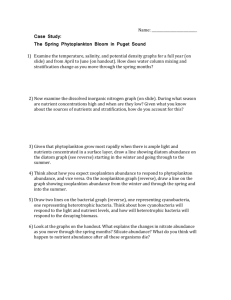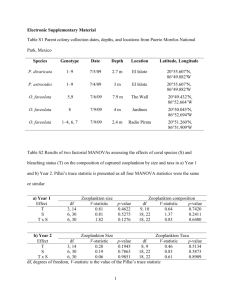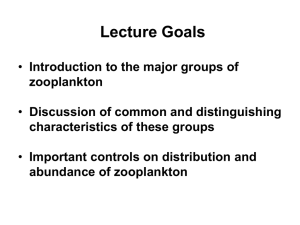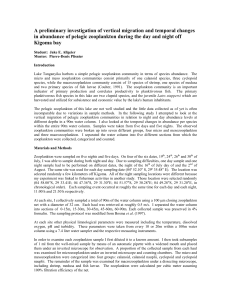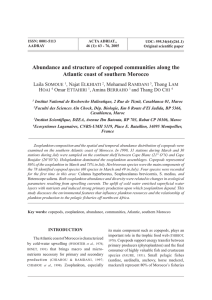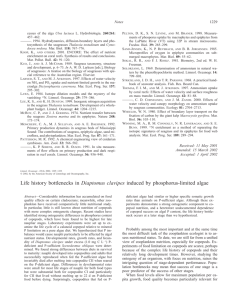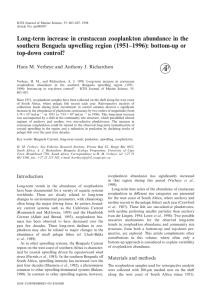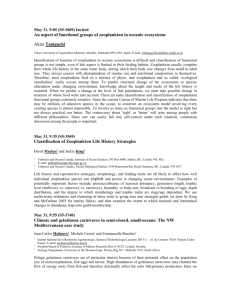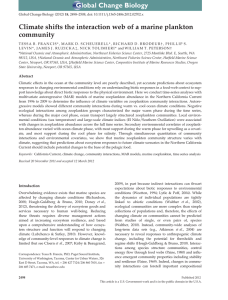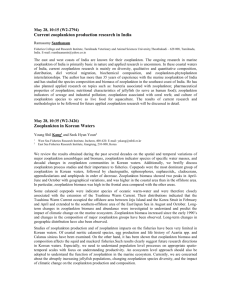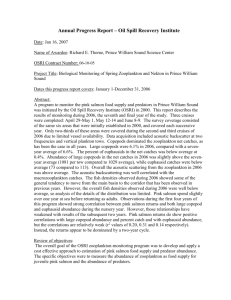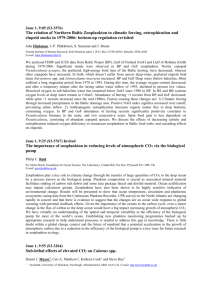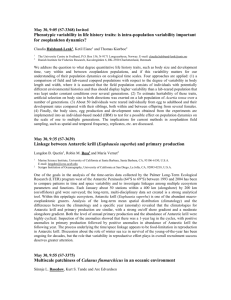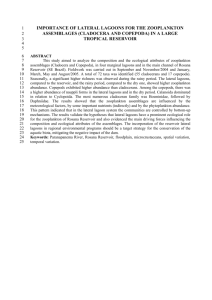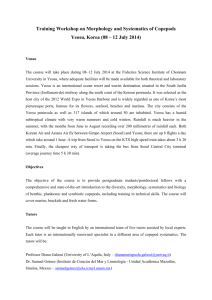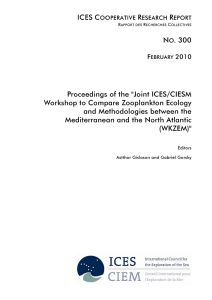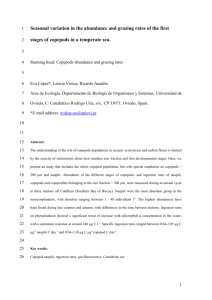Marine Zooplankton Community Composition Taxa Abundance
advertisement
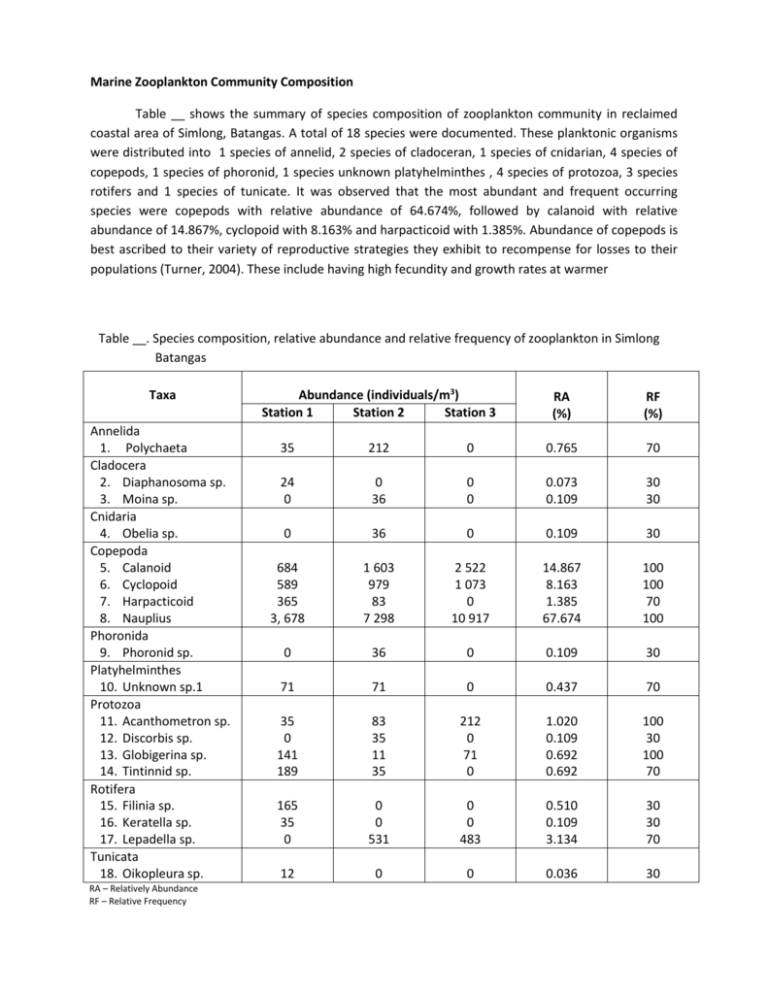
Marine Zooplankton Community Composition Table __ shows the summary of species composition of zooplankton community in reclaimed coastal area of Simlong, Batangas. A total of 18 species were documented. These planktonic organisms were distributed into 1 species of annelid, 2 species of cladoceran, 1 species of cnidarian, 4 species of copepods, 1 species of phoronid, 1 species unknown platyhelminthes , 4 species of protozoa, 3 species rotifers and 1 species of tunicate. It was observed that the most abundant and frequent occurring species were copepods with relative abundance of 64.674%, followed by calanoid with relative abundance of 14.867%, cyclopoid with 8.163% and harpacticoid with 1.385%. Abundance of copepods is best ascribed to their variety of reproductive strategies they exhibit to recompense for losses to their populations (Turner, 2004). These include having high fecundity and growth rates at warmer Table __. Species composition, relative abundance and relative frequency of zooplankton in Simlong Batangas Taxa Annelida 1. Polychaeta Cladocera 2. Diaphanosoma sp. 3. Moina sp. Cnidaria 4. Obelia sp. Copepoda 5. Calanoid 6. Cyclopoid 7. Harpacticoid 8. Nauplius Phoronida 9. Phoronid sp. Platyhelminthes 10. Unknown sp.1 Protozoa 11. Acanthometron sp. 12. Discorbis sp. 13. Globigerina sp. 14. Tintinnid sp. Rotifera 15. Filinia sp. 16. Keratella sp. 17. Lepadella sp. Tunicata 18. Oikopleura sp. RA – Relatively Abundance RF – Relative Frequency Abundance (individuals/m3) Station 1 Station 2 Station 3 RA (%) RF (%) 35 212 0 0.765 70 24 0 0 36 0 0 0.073 0.109 30 30 0 36 0 0.109 30 684 589 365 3, 678 1 603 979 83 7 298 2 522 1 073 0 10 917 14.867 8.163 1.385 67.674 100 100 70 100 0 36 0 0.109 30 71 71 0 0.437 70 35 0 141 189 83 35 11 35 212 0 71 0 1.020 0.109 0.692 0.692 100 30 100 70 165 35 0 0 0 531 0 0 483 0.510 0.109 3.134 30 30 70 12 0 0 0.036 30 temperatures. They also tend regulate their motion and respiration at lower rates that allows investment of more energy for reproduction, maximizing their lifetime reproductive output. These characters allow copepods to increase their abundance even during unfavorable conditions. In connection with this, the copepod nauplius is the most abundant (67.674%) among the zooplankton taxa in the marine community. The high abundance of these young forms of copepods is generally result of the continuous reproduction of these organisms (Neves et al., 2003). Also, nauplius represent all copepod species at larval stage, which most likely the reason of their abundance within study site. This finding is further supported by the relative abundance of copepods in the community which account 92.091% (figure __). Among the zooplankton species collected nauplius (67.674%) and calanoid (14.867%) were the most abundant species. According to Gannon and Stemberger (1978) and Maier (1996) presence and abundance of calanoid is an indicator of eutrophic aquatic system. Whereas in the study of Fines (2012), calanoid species, Calanus finmarchicus turned out to be an indicator species for oil pollution since these copepod can accumulate oil in its system without drastically decrease in their population. On the other hand, abundance of nauplius is also associated with high level of eutrophication due to their wide range of trophic level index (Patalas, 1972 and Gannon and Stemberger 1978). Water condition of Simlong Batangas satisfies these water quality condition in which anthropogenic disturbance along the coastal area is rampant that can be possibly the cause of eutrophication in the area. Moreover, the industrial corporation in the periphery of the coastal area adds oil pollutant in the seawater that could deteriorate the water quality of the coastal sea. Considering the presence of indicator species and the observed anthropogenic disturbance in the area it is then determined that the coastal of Simlong Batangas is experiencing eutrophication and pollution. 9 0.036 8 0.036 7 6 3.754 2.515 5 0.437 4 0.109 92.091 3 2 0.109 1 0.948 1 – Annelida, 2 – Cladocera, 3 – Cnidaria, 4 – Copepoda, 5 – Phoronida, 6 – Platyhelminthes, 7 – Protozoa, 8 – Rotifera, 9 - Tunicata Figure __. Relative abundance of major zooplankton group in Simlong, Batangas Zooplankton Community Characteristics Table __ shows the summary of the community characteristics of zooplankton present in Simlong, Batangas during the sampling period. A total of forty eighteen (18) taxa of zooplankton were documented all throughout the study site. Highest number of taxa was observed in Station 2 (S=14), followed by Station 1 (S=13), and Station 3 (S=6), respectively. Perceptible differences may be due to the distant location of Station 2 from anthropogenic disturbance. Station 3 is situated near the residential area and is more likely exposed to human disturbances and receives more effluents from various anthropogenic activities whereas station 1 is situated near the reclaimed powerplant area. The computed values of dominance was highest in Station 3 (D=0.544) and lowest in Station 1 (D=0.402). Low overall value for dominance indicates that no taxa severely dominated the community. Conversely, values of Shannon-Wiener index (H’) and Simpson’s Diversity index (1-D) was highest in Station 2 (H’=1.196; 1-D=0.532) and lowest in Station 3 (H’=0.918; 1-D=0.456). The computed overall value for zooplankton was low (H’=1.169; 1-D=0.512), which can be directly attributed to be human stressor the coastal region receives. Lastly, the calculated value for evenness (E=0.179) was high which means that the individuals in the study site are evenly distributed among the different species. Table __. Community characteristics of zooplankton in Simlong, Batangas Station 1 2 3 Overall Margalef’s Species Richness (S) 13 14 6 18 Dominance (D) 0.402 0.468 0.544 0.488 ShannonWiener Index (H’) 1.417 1.196 0.918 1.169 Simpson’s Diversity Index (1-D) 0.598 0.532 0.456 0.512 Evenness (E) 0.317 0.236 0.417 0.179 Literature Cited: Turner, J. T. 2004. The importance of small planktonic copepods and their roles in pelagic marine food webs. Zoological Studies 43(2): 255-266 Neves, I. F., O. Rocha, K. Roche and A. A. Pinto. 2003. Zooplankton Community Structure of Two Marginal Lakes of the River Cuiabá (Mato Grosso, Brazil) with Analysis of Rotifera and Cladocera Diversity. Braz. J. Biol., 63(2): 329-343 Maier, G. 1996. Copepod communities in lakes of varying trophic degree. Arch. Hydrobiol. 136: 455–465. Gannon, J.E. and Stemberger, R.S. 1978. Zooplankton (especially crustaceans and rotifers) as indicators of water quality. Trans. Am. Microsc. Soc., 97:16-35 Patalas, K. 1972. Crustacean plankton communities in forty- five lakes in the experimental lakes area, northwestern Ontario. J. Fish. Res. Bd. Can. 28: 231-244. Fites, I. 2012. Effects of Crude Oil Water Accommodated Fractions (WAF) on the Escape Behaviour in Calanus finmarchicus Gunnerus (Copepoda). Norwegian University of Science and Technology, Department of Biology

